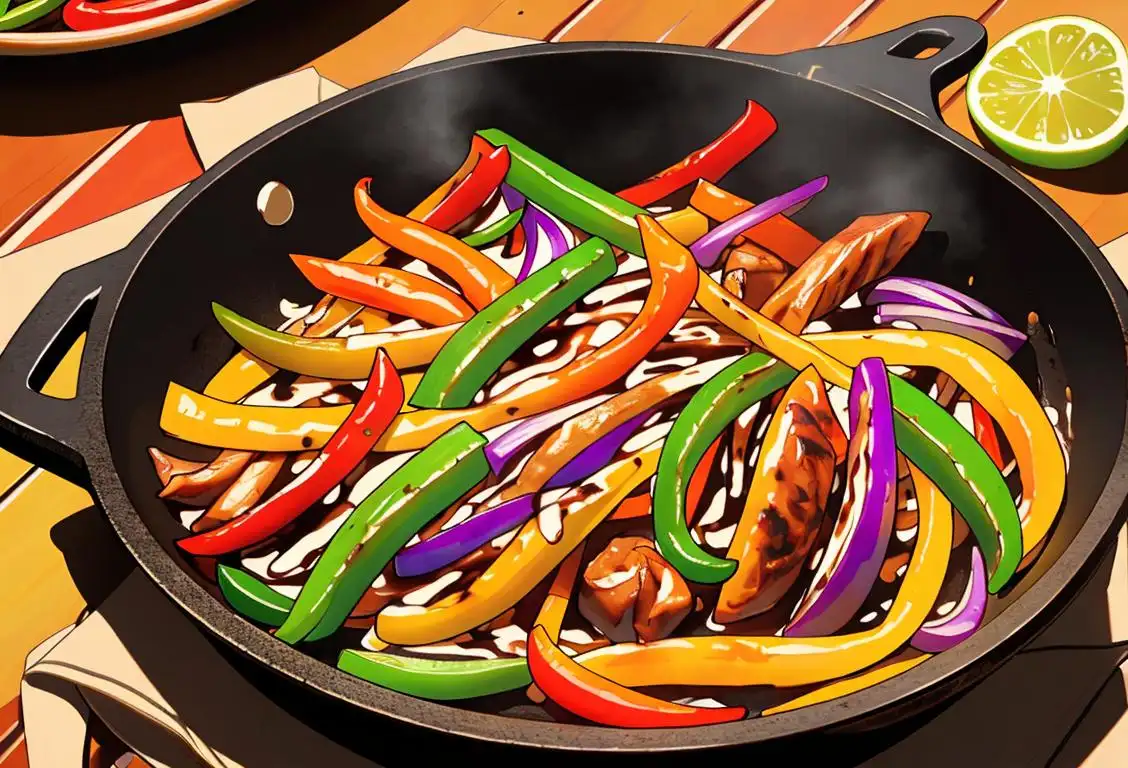National Fajitas Day

Are you ready to sizzle? Because today we're celebrating National Fajitas Day! Get your taste buds and your cowboy boots ready, because we're about to dive into the delicious world of sizzling strips of meat and veggies served with warm tortillas. It's time to fiesta like there's no tomorrow!
When is Fajitas Day?
It's national fajitas day on the 18th August.
The Sizzling History of National Fajitas Day
Did you know that fajitas have a fascinating history? The origin of this flavorful Tex-Mex dish can be traced back to the ranch workers in West Texas and Northern Mexico in the late 1930s. These hardworking cowboys needed a quick and hearty meal, and fajitas fit the bill perfectly.
Back in the day, the tough cuts of beef, such as skirt steak, were used because they were cheap and readily available. The word 'fajita' itself comes from the Spanish word 'faja,' which means 'belt' or 'sash.' It refers to the cut of meat commonly used for fajitas, which is a long, narrow strip similar to a belt or sash.
During cattle roundups, the ranch hands would grill the skirt steak over an open fire. Not only was it an essential source of nourishment, but it was also a tasty reward for their hard work. The mouths of the cowboys would water as the captivating aroma filled the air.
Fast forward a few decades, and fajitas became a popular dish in Tex-Mex restaurants across the United States. The sensational sizzling platters, where the meat and veggies arrive at your table still sizzling, became a trademark of fajita feasts. The sound and smell of a sizzling fajita skillet can make even the grumpiest of tummies rumble with anticipation.
Celebrate National Fajitas Day
Now that you know the history, it's time to grab your cast iron skillet and celebrate National Fajitas Day! Invite your loved ones, put on your favorite apron, and let's get cooking!
Start by marinating your favorite cut of meat in a mouthwatering blend of spices and citrus juices. If you're a veggie lover, you can replace the meat with grilled peppers, onions, and mushrooms - it's just as delicious!
Sizzle up your fajitas on a hot grill or stovetop and watch the magic happen. Once perfectly cooked, serve them on warm flour tortillas and pile on the toppings. From fresh guacamole to tangy salsa and cool sour cream, the choice is yours.
Don't forget to squeeze a bit of lime over your fajitas for that extra burst of flavor. And of course, it wouldn't be a fiesta without some margaritas or ice-cold cervezas to wash it all down.
Did You Know?
Did you know that the world's largest fajita ever made weighed over two thousand pounds? Yes, you read that right! It took a team of chefs in Austin, Texas, to create this massive masterpiece. Talk about a mouthwatering challenge!
History behind the term 'Fajitas'
1930s
Mexican Cowboys and Skirt Steak
In the 1930s, fajitas originated in the ranch lands of West Texas and Northern Mexico. Mexican cowboys, known as vaqueros, would cook skirt steak, a flavorful and inexpensive cut of beef, over an open fire. Skirt steak was often given to the cowboys as part of their payment, as it was considered a less desirable cut at the time.
1930s
The Origins in Mexican Ranches
In the 1930s, the term 'fajitas' first emerged in the ranchlands of northern Mexico. It was used to describe a cut of beef called 'arrachera,' which was traditionally marinated and grilled over an open fire. The term 'fajitas' comes from the word 'faja,' which means 'belt' in Spanish and refers to the skirt steak's shape and long, flat appearance.
1930s
Chicken thrown away
In the 1930s, during cattle roundups in the Southwest United States, Mexican vaqueros (cowboys) were often given the undesirable cuts of meat, such as the skirt steak. Instead of wasting these cuts, the resourceful vaqueros would marinate and cook them over a fire, creating a delicious and flavorful dish.
1940s
Texan Influence
During the 1940s, the popularity of fajitas began to rise, particularly in the Texas-Mexico border region. Mexican families who migrated into Texas started selling the marinated skirt steak as 'taco meat.' The flavorful and tender meat quickly became a hit among locals and gained a reputation as a staple Tex-Mex dish.
1940s
Marinating and Tenderizing
During the 1940s, Mexican vaqueros started marinating and tenderizing skirt steak to make it more flavorful and tender. They would typically use a mixture of lime juice, garlic, and various spices to add flavor and break down the tough fibers of the meat.
1940s
Rise of Fajitas in South Texas
In the 1940s, the popularity of 'fajitas' expanded across the border into South Texas, where Mexican-American cattle ranchers brought their traditions and culinary skills. It became a favorite dish among the workers in the cattle ranches and local markets, known for its delicious flavors and tender texture. Fajitas were initially a humble and inexpensive dish.
1969
Fajitas Gain Mainstream Attention
In 1969, fajitas started gaining mainstream attention beyond the ranching communities. Sonny Falcon, a meat market manager in Houston, introduced fajitas to a wider audience by promoting skirt steak as 'fajitas' and suggesting various serving methods. This marketing strategy successfully sparked curiosity and quickly turned fajitas into a sought-after item in Tex-Mex cuisine.
1960s
Introduction to American Consumers
In the 1960s, fajitas made their way to the United States thanks to a meatpacking plant in Texas. The plant started packaging and selling skirt steak specifically as 'fajita meat' to appeal to American consumers. At this time, fajitas were primarily consumed by the Mexican-American communities in the Southwest.
1960s
Restaurant Introduction
In the 1960s, Sonny Falcon, a popular meat market owner in Kyle, Texas, first introduced fajitas as a menu item at his family-owned fajita stand and later at their restaurant, The Roundup. The flavorful grilled meat, served with tortillas, grilled onions, and other accompaniments, became a sensation and drew crowds from all around the state.
1980s
Fajitas Go National
By the 1980s, fajitas had gained widespread popularity across the United States. They became a staple in Tex-Mex and Mexican-American restaurants, with their sizzling presentation on a cast-iron skillet becoming a trademark of the dish. Fajitas were no longer limited to South Texas but had successfully permeated the culinary landscape throughout the nation.
1980s
National Recognition
By the 1980s, fajitas gained national recognition and spread beyond Texas, becoming a popular dish in Mexican-American restaurants across the United States. The sizzling platters of fajitas, served with tortillas and an array of toppings, became synonymous with Tex-Mex cuisine and a favorite choice among diners.
1971
Fajitas in Print
The term 'fajitas' was first documented in print in a 1971 article by Diana Kennedy, a renowned cookbook author and expert in Mexican cuisine. Her article described the dish as a sizzling platter of grilled meat, typically served with tortillas, guacamole, and salsa. This increased the popularity and recognition of fajitas among a wider audience.
1980s
Restaurant Craze and Cultural Influence
The 1980s saw a surge in the popularity of fajitas across the United States. Mexican restaurants, especially chains like Chili's, popularized the sizzling fajita platters, making them a staple on menus nationwide. Fajitas became synonymous with Tex-Mex cuisine and had a significant impact on American food culture.
Present
Fajitas as a Global Phenomenon
Today, fajitas have become a global phenomenon and are enjoyed by people of various cultures worldwide. They have evolved beyond the traditional beef filling and can be found with a wide range of ingredients, including chicken, shrimp, and even vegetarian options. Fajitas have cemented their place in the culinary world, representing a delicious fusion of Mexican and Texan flavors.
Did you know?
Did you know that the world's largest fajita ever made weighed over two thousand pounds? Yes, you read that right! It took a team of chefs in Austin, Texas, to create this massive masterpiece.Tagged
food fun loved onesFirst identified
18th August 2016Most mentioned on
18th August 2016Total mentions
29Other days
Biscuit Day
Cheese Lovers Day
Cheese Pizza Day
Agriculture Day
Bacon Day
Medal Of Honor Day
Pumpkin Day
Foundation Day
Guac Day
Drink A Beer Day









